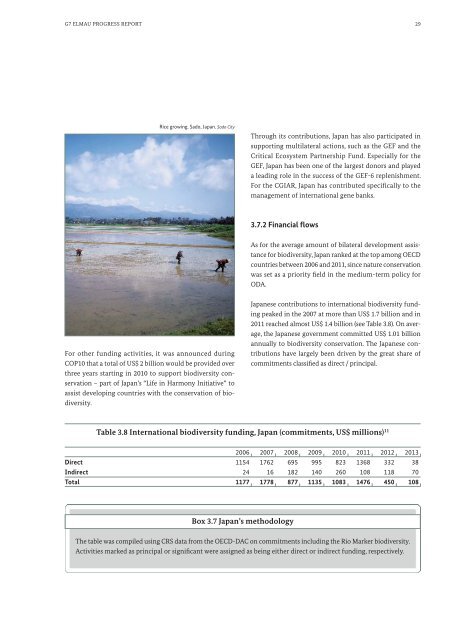28 <strong>G7</strong> ELMAU PROGRESS REPORT3.7 Japan3.7.1 Priorities of Japan’s biodiversity fundingJapan has participated in international cooperation ef<strong>for</strong>tsin the field of biodiversity and supported developing countriesthrough international financial mechanisms. TheJapanese government will continue to take action on biodiversityconservation while applying a global perspective.More specifically, it will assist developing countries withtheir capacity <strong>development</strong> ef<strong>for</strong>ts toward the achievementof the Aichi <strong>Biodiversity</strong> Targets, promote <strong>sustainable</strong>conservation of human-influenced natural environmentsthrough the Satoyama Initiative and participate in internationalcooperation centered on the Asia-Pacific region, whichhas a close connection with Japan. In order to promoteef<strong>for</strong>ts based on the CBD, including the achievement of theAichi <strong>Biodiversity</strong> Targets at the global level, it is stronglybelieved that global ef<strong>for</strong>ts are needed to provide funds,transfer technology and conduct capacity <strong>development</strong><strong>for</strong> developing countries. There<strong>for</strong>e, Japan established theJapan <strong>Biodiversity</strong> Fund, consisting of JP¥ 5 billion (US$59 million) in contributions from the government of Japan.The aim is to support developing countries to develop capacityin implementing the CBD Strategic Plan 2011–2020and the Aichi <strong>Biodiversity</strong> Targets, along with the revisionMonitoring survey of the Programme <strong>for</strong> Bornean <strong>Biodiversity</strong> and EcosystemsConservation. Crocker Range Park, Japan. Japan International Cooperation Agencyof their National <strong>Biodiversity</strong> Strategies and Action Plans(NBSAPs) in accordance with the CBD Strategic Plan, andto strengthen their capacity to implement the Convention.In order to achieve these goals, the CBD Secretariat is conductingvarious activities under the Japan <strong>Biodiversity</strong> Fund,including regional and sub-regional workshops, such asNBSAP capacity-building workshops, public awarenesscampaigns and capacity-building activities.The Japan International Cooperation Agency (JICA) conductsvarious activities to support the conservation of biodiversityin developing countries. 10 For example, JICAprovides technical cooperation aimed at improving techniques<strong>for</strong> the recovery of ecosystems, and supports the<strong>development</strong> of the research capabilities of administrativeofficials and researchers. JICA also provides assistance toincrease awareness among local citizens through environmentaleducation, and to develop and disseminate agriculturaltechniques with the objectives of raising productivitylevels and conserving the environment. Other initiativesaim to enhance and improve policies, systems and theorganizational structures necessary <strong>for</strong> the appropriatemanagement of nature reserves and national parks.The significance of biodiversity was also underscoredby the Japanese government at COP10 in October 2010,when it hosted the conference in Nagoya. As a governmentalorganization implementing Japan’s official assistance,JICA will continue to disseminate the knowledge gainedthrough its years of international cooperation activitiesand further promote biodiversity conservation in cooperationwith other countries. In addition to providing assistance,it is <strong>vital</strong> that developing countries are given thetools to be able to conserve the environment under theirown direction. JICA teamed up with players from varioussectors (local government, ministries, local citizens, nongovernmentalorganizations (NGOs), companies, etc.) tocreate a system to promote conservation activities. Anexample of one such partnership can be found in Ethiopia– a country that suffers from serious <strong>for</strong>est degradation –where JICA collaborates with private companies to assistthe country in acquiring certification from an environmentalNGO so that its wild coffee can be exported at a premiumprice. This activity has helped farmers to increase theirincomes while retaining their <strong>for</strong>est resources.
<strong>G7</strong> ELMAU PROGRESS REPORT 29Rice growing. Sado, Japan. Sado CityThrough its contributions, Japan has also participated insupporting multilateral actions, such as the GEF and theCritical Ecosystem Partnership Fund. Especially <strong>for</strong> theGEF, Japan has been one of the largest donors and playeda leading role in the success of the GEF-6 replenishment.For the CGIAR, Japan has contributed specifically to themanagement of international gene banks.3.7.2 Financial flowsAs <strong>for</strong> the average amount of bilateral <strong>development</strong> assistance<strong>for</strong> biodiversity, Japan ranked at the top among OECDcountries between 2006 and 2011, since nature conservationwas set as a priority field in the medium-term policy <strong>for</strong>ODA.For other funding activities, it was announced duringCOP10 that a total of US$ 2 billion would be provided overthree years starting in 2010 to support biodiversity conservation– part of Japan’s “Life in Harmony Initiative” toassist developing countries with the conservation of biodiversity.Japanese contributions to international biodiversity fundingpeaked in the 2007 at more than US$ 1.7 billion and in2011 reached almost US$ 1.4 billion (see Table 3.8). On average,the Japanese government committed US$ 1.01 billionannually to biodiversity conservation. The Japanese contributionshave largely been driven by the great share ofcommitments classified as direct / principal.Table 3.8 International biodiversity funding, Japan (commitments, US$ millions) 112006 2007 2008 2009 2010 2011 2012 2013Direct 1154 1762 695 995 823 1368 332 38Indirect 24 16 182 140 260 108 118 70Total 1177 1778 877 1135 1083 1476 450 108Box 3.7 Japan’s methodologyThe table was compiled using CRS data from the OECD-DAC on commitments including the Rio Marker biodiversity.Activities marked as principal or significant were assigned as being either direct or indirect funding, respectively.


